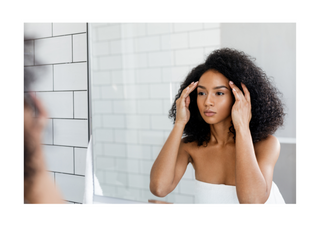Skin is a complex organ. It's the body's largest organ, and it performs incredible functions that serve to maintain health everywhere in our body. For example, skin acts as a waterproof shield, protects us from harmful external toxins, regulates body temperature, communicates health information, and so much more.
However, the importance of healthy skin is often overlooked by many, and basic skin care fundamentals are largely misunderstood by both men and women.
Learning the fundamentals of great skincare is a great way to improve the health and appearance of your skin's natural beauty. In this article, we share information and tips on assessing your skin's unique care needs.
Skincare Fundamentals: How Does Skin Work?
Understanding how your skin works can reveal insightful answers on how you can best support it. Without losing you in juicy skin science, let's focus on the skin's 3 primary layers and their key functions.
Epidermis:
The outermost layer of the skin is called the epidermis. It is a thin layer whose primary function is to prevent pathogens and contaminants from entering the body. 80% of the epidermis is made up of Keratinocyte cells. These cells are what protects the skin's barrier defence systems.
Maintaining a healthy epidermis layer is critical for beautiful skin and a healthy body. The layer is relatively thin - it's less than 0.05mm thick on the eyelids and requires gentle care. Over stripping the epidermis can lead to signs of damaged skin. Possible symptoms of poor epidermis health can include:
- Hyperpigmentation
- Acne
- Rosacea
- Dry skin
Dermis
The dermis, the second layer of your skin, is the thickest skin layer and is a busy and active area of your skin. Functions that occur within the dermis layer include collagen and elastin production, healing tissue, pain and pleasure sensations, and the facilitation of hair growth.
The dermis layer is also where our oil-producing glands, called sebaceous glands, are located in our skin. They are essential to balance the moisture of our skin. However, if the sebaceous glands become overactive, the skin can become oily. Causes of overactive oil glands can include:
- Enlarged Pores
- Age
- Improper skin care products selection
- Genetics
- Environment
The best way to position yourself for having great-looking skin for a lifetime is to protect your dermis layer from sun damage. This is why it's crucial to use a Mineral Broad Spectrum sunscreen on your skin every day.
Improving the health of your face's dermis layer can also be aided by applying a moisture-balancing toner after cleansing the skin. This will help your dermis layer lock in moisture, balance oil production, and reduce the fine lines of aging.
Subcutaneous Tissue
Subcutaneous tissue is a layer of fat lying between your skin and muscles, which provides padding for the body and protects it from injury. It helps regulate body temperature by giving insulation that prevents overheating or cooling from external conditions.
Naturally, as we age, the fatty, subcutaneous layer thins. This typically results in skin that appears less smooth. Also, veins can become more visible. For example, suppose the appearance of thin, spider web-like veins are beginning to show on your cheeks. In that case, it's a good indication that the subcutaneous layer of your facial skin has undergone thinning.
Skincare Fundamentals: Assessing Your Skin
Assessing your skin is an easy way to take a minute and review what your skincare needs are. This will help guide you towards a better understanding of your skin and how you can support its unique needs. Thereby enhancing your skin's appearance, texture, and health.
A thorough skin care assessment requires three simple steps.
Step 1: Wash Your Face
Using your daily cleanser, wash your face as you usually would. This will remove any makeup, impurities, and other contaminants from your skin's delicate surface.
Step 2: Rest for 30 Minutes
Take a break! Sit back and relax for thirty minutes. During this time, your skin will recover from the cleansing process and begin to reveal valuable information about its health and well-being. Resist applying any products and just let your skin relax and do its job.
Step 3: Observe Your Skin
Once your skin is clean and allowed to "just be" for a half-hour, take a close look at your skin. Try to understand what your skin is telling you. Be sure to be kind to yourself and don't allow negative self-talk to enter this observation time. Your skin is beautiful. Appreciate all the work it does for your body and appreciate how fantastic skin truly is!
Step 4: Record Your Observations
Jot down any observations you may have during this time of reflection. A few questions to answer can be:
- How does my skin feel? Is it smooth, rough, bumpy, or a mixture of all three?
- How does my skin look? Is it shiny, dull, or glowing?
- Are there areas of concern, and what are they?
- What features of your skin do you love?
Skincare Fundamentals: Find Your Best Skin Care Routine
Overall, thinking of your beautiful skin's cellular composition will help you realize topical skincare products are limited. They can only treat and support your skin's outermost layer, which is the epidermis. Unless, of course, you use a prescription topical like Retinoid.
Therefore, the workhorse of your skincare routine will always be linked to your overall health and wellness. Examples of great skincare treatments that may surprise you include:
- Eating well. Be sure to include an abundance of fresh produce in your diet.
- Drink water.
- Be Positive!
- Use well-formulated products that work for your unique skin care needs.
- Exercise regularly. Dance, Walk, Run. Do whatever feels right for you, it’s so important to move DAILY as we tend to sit so much.
Remember, the skin can only produce as well as it receives.
Start Your Skincare Wellness Program with Glow Jar
Your skin is as individual and unique as your own personality. It has nuances and needs that are specific to only you. That's why finding the right skincare program should be a loving, personal experience that considers your goals and your skin's needs.
At Glow Jar Beauty, we have developed a skincare wellness program that delivers the information you need to understand what your skin needs to look its best. To learn more about this delightful, self-care-centric program, click here.

